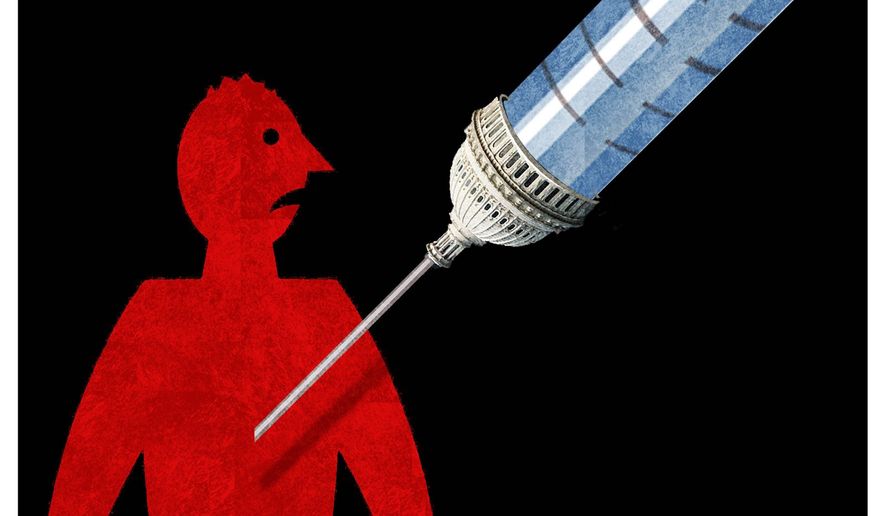OPINION:
Last week I wrote, and The Washington Times ran, a column arguing that, whatever else they are, the “vaccines” are not vaccines like you and I understand that term. Not surprisingly, Facebook flagged the column, and it was subject to at least one “fact” check.
Let’s try again.
In explicitly using the word “vaccine,” the Centers for Disease Control and Prevention and the remainder of the federal government have relied upon how English speakers translate that word. To all of us, it means something that provides immunity to the vaccinated and precludes them from transmitting the disease.
The historical examples are obvious and apparent: polio, smallpox.
How about the efficacy of other vaccines compared to the COVID-19 shots?
The CDC indicates that two doses of the ubiquitous MMR vaccine are 97% effective against measles and 100% effective against rubella. Today’s Parent reports that the chickenpox vaccine is about 100% effective in preventing serious chickenpox.
The CDC tells us: “Before the whooping cough vaccines were recommended for all infants, about 8,000 people in the United States died each year from whooping cough. Today, because of the vaccine, this number has dropped to fewer than 20 per year.” That makes it more than 99% effective.
How about the COVID-19 shots?
In August, the Institute for Health Metrics and Evaluation, an independent global health research center at the University of Washington, took a look at the efficacy of the various shots. It concluded that their efficacy in preventing infection ranged from 56% (Johnson and Johnson) to 80% (Moderna). That was, of course, well before the omicron surge. Efficacy in preventing infection is now, of course, much lower than that.
In December, the Mayo Clinic assessed the efficacy of the shots in preventing disease (not preventing infection). Those numbers were better but still low compared to other vaccines. Moderna was 94% effective; Pfizer was 91% effective; Johnson and Johnson was 66% effective.
All of those numbers, of course, have changed. Now that omicron is scything through the population, we have more than 60 million cases that we know of. There can be no doubt that the actual number of infections among the vaccinated and unvaccinated are much higher, as many people cannot get tests, are not sharing the results of their at-home test or are experiencing symptoms below their own personal threshold of concern.
Let’s be clear: Health outcomes appear to be better for those who have taken the shots, although it is not at all clear that taking the shots makes a material difference to the young and healthy.
Let’s also be clear about the nature of the disease. It is a highly contagious respiratory disease that mutates more rapidly than we can adjust to. It will eventually infect everyone.
That alone suggests that the efficacy of the “vaccines” in preventing transmission and infection will eventually reach zero, as everyone in the population contracts the disease and can transmit it.
At some point — and we may already be there — the efficacy of the “vaccines” will drop below 50%, the threshold at which the World Health Organization recommends against approval of vaccines.
Doctors and public health officials, of course, know all this. Way back in August, the director of the CDC said of the vaccines: “… what they can’t do anymore is prevent transmission.”
In that same story, Adm. Brett Giroir, one of the coronavirus chieftains under former President Donald Trump, said: “The next variant is just around the corner if we do not all get vaccinated.” Adm. Giroir was either lying or hopelessly misinformed. The next variant (omicron) has spread through the population irrespective of “vaccination” status.
Public health professionals — like Adm. Giroir — chose the word “vaccine” specifically to induce the sort of societal opprobrium toward the “unvaccinated” that has followed, including the marginalization of those who choose to take other preventive measures or pursue other therapies.
The tragic thing is that the shots seem to be excellent therapeutics. In the hands of a nonpoliticized and truthful public health community, they would have been taken by pretty much everyone without the societal friction accompanying them.
This column will no doubt be flagged as well. That’s fine. We’ll do another column when the CDC acknowledges that the efficacy rate has dropped below 50%. We’ll do another column when it eventually gives up on the propaganda, but no amount of flagging or “fact” checking will save the credibility of the public health professionals.
They were wrong about lockdowns. They were wrong about school lockouts. They were wrong about the masks. The guidance has been a clown show. They intentionally mischaracterized the nature of the shots. Last weekend, the director of the CDC was unable to say with clarity how many of the 836,000 deaths counted by the CDC were from COVID-19 or with COVID-19.
But by all means, keep listening to the “experts.”
• Michael McKenna, a columnist for The Washington Times, is a co-host of “The Unregulated” podcast. He was most recently a deputy assistant to the president and deputy director of the Office of Legislative Affairs at the White House.
For more information, visit The Washington Times COVID-19 resource page.




Please read our comment policy before commenting.